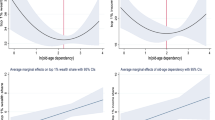Abstract
This is a progress report on ongoing research into the effects of economic and population growth on national saving rates and inequality. The theoretical basis for the investigation is the life cycle model of saving and inequality. We report evidence that is conditional on the validity of the model, as well as evidence that casts doubt on it. Using time series of cross-sectional household surveys from Taiwan, Thailand, Britain, and the United States, we show that it is possible to force a life cycle interpretation on the data on consumption, income, and saving, but that the evidence is not consistent with large rate-of-growth effects, whereby economic and population growth enhances rates of national saving. The well-established cross-country link between economic growth and saving cannot be attributed to life cycle saving, nor will changes in economic or population growth exert large effects on saving within individual countries. There is evidence in favor of the life cycle model’s prediction that within-cohort inequality of consumption and of total income—though not necessarily inequality of earnings-—should increase with the age of the cohort. Decreases in the population growth rate redistribute population toward older, more unequal, cohorts, and can increase national inequality. We provide calculations on the magnitude of these effects.
Similar content being viewed by others
References
Bosworth, B.P., G. Burtless, and J. Sabelhaus. 1991. “The Decline in Saving: Evidence from Household Surveys.” Pp. 183–241 in Brookings Papers on Economic Activity, No. I. Washington, DC: Brookings Institution.
Carroll, C. Forthcoming. Buffer-stock Saving and the Life Cycle/ Permanent Income Hypothesis. Quarterly Journal of Economics.
Carroll, C. and L.H. Summers. 1991. “Consumption Growth Parallels Income Growth: Some New Evidence.” Pp. 305–43 in National Saving and Economic Performance, edited by B.D. Bernheim and J.B. Shoven. Chicago: University of Chicago Press for National Bureau of Economic Research.
Deaton, A.S. 1992. Understanding Consumption. Oxford: Clarendon Press.
Deaton, A.S. and C.H. Paxson. 1992. “Patterns of Aging in Thailand and Cote d’Ivoire.” Pp. 163–206 in Topics in the Economics of Aging, edited by D.A. Wise. Chicago: University of Chicago Press.
— 1994a. “Intertemporal Choice and Inequality.” Journal of olitical Economy 102:437–67.
— 1994b. “Saving, Growth, and Aging in Taiwan.” Pp. 331–57 in Studies in the Economics of Aging, edited by D.A. Wise. Chicago: University of Chicago Press for National Bureau of Economic Research.
— 1995. “Saving, Inequality, and Aging: An East Asian Perspective.” Asia-Pacific Economic Review 1:7–19.
Gersovitz, M. 1988. “Saving and development.” Pp. in 382–424 Handbook of Development Economics, edited by H. Chenery and T.N. Srinivasan. New York: American Elsevier.
Hall, R.E. 1978. “Stochastic Implications of the Life Cycle-Permanent Income Hypothesis: Theory and Evidence.” Journal of Political Economy 86:971–87.
Hermalin, A.I., M.B. Ofstedal, and M.-C. Chang. 1991. “Types of Support for the Aged and Their Providers in Taiwan.” Unpublished manuscript. Population Studies Center, University of Michigan.
Hubbard, R.G., J. Skinner, and S.P. Zeldes. 1995. “Precautionary Saving and Social Insurance.” Journal of Political Economy 103:360–99.
Keyfitz, N. and W. Flieger. 1990. World Population Growth and Aging: Demographic Trends in the Late Twentieth Century. Chicago: University of Chicago Press.
Lee, R.D. 1994. “The Formal Demography of Population Aging, Transfers, and the Economic Life Cycle.” Pp. 8–49 in The Demography of Aging, edited by L.G. Martin and S.H. Preston. Washington, DC: National Academy Press.
Lee, R.D. and S. Lapkoff. 1988. “Intergenerational Flows of Time and Goods: Consequences of Slowing Population Growth.” Journal of Political Economy 96:618–51.
Mincer, J. 1974. Schooling, Experience, and Earnings. New York: Columbia University Press for the National Bureau of Economic Research.
Modigliani, F. 1970. “The Life-Cycle Hypothesis of Saving and Intercountry Differences in the Saving Ratio.” Pp. 197–225 in Induction, Trade, and Growth: Essays in Honour of Sir Roy Harrod, edited by W.A. Eltis, M.F.G. Scott, and J.N. Wolfe. Oxford: Clarendon Press.
— 1986. “Life-Cycle, Individual Thrift, and the Wealth of Nations.” American Economic Review 76:297–313.
— 1990. “Recent Declines in the Savings Rate: A Life Cycle Perspective.” Rivista di Politica Economica December:5–42.
Paxson, C.H. 1996. “Saving and Growth: Evidence from Micro Data.” European Economic Review 40:255–88.
U.S. Department of Commerce. 1993. An Aging World II. International Population Reports P95/92-3. Washington, DC: U.S. Bureau of the Census.
Author information
Authors and Affiliations
Corresponding author
Additional information
This research was supported by Grants POI-AG05842 and ROI-AGI1957 from the National Institute of Aging. We would like to thank two anonymous referees for useful comments. Christina Paxson also thanks the Russell Sage Foundation for support.
Rights and permissions
About this article
Cite this article
Deaton, A.S., Paxson, C.H. The effects of economic and population growth on national saving and inequality. Demography 34, 97–114 (1997). https://doi.org/10.2307/2061662
Issue Date:
DOI: https://doi.org/10.2307/2061662




